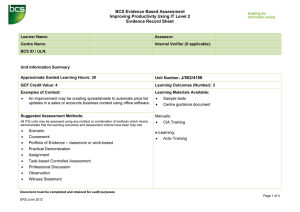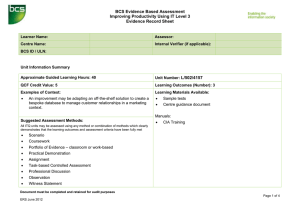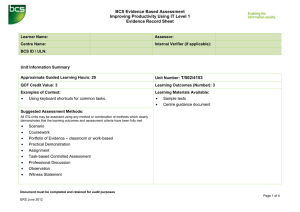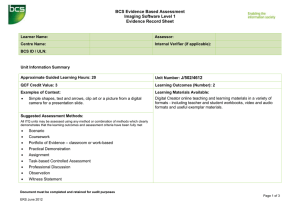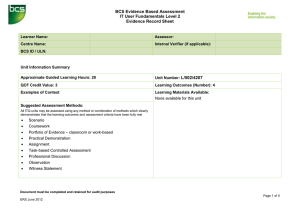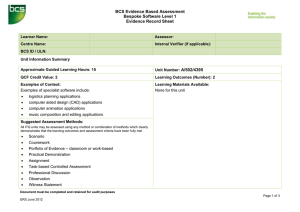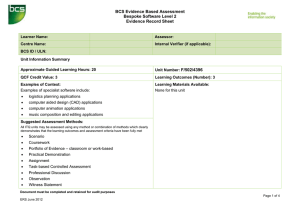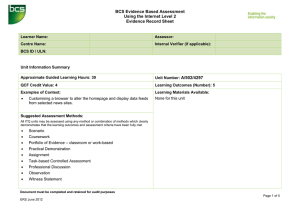BCS Evidence Based Assessment IT Security for Users Level 3
advertisement
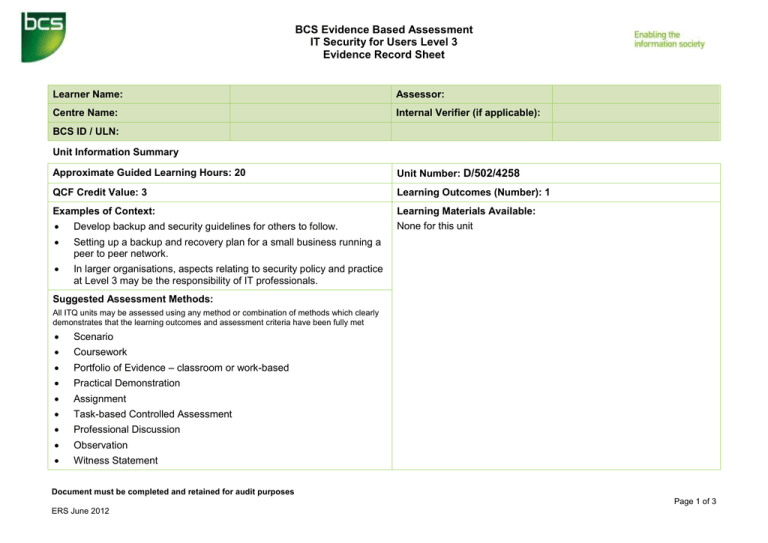
BCS Evidence Based Assessment IT Security for Users Level 3 Evidence Record Sheet Learner Name: Assessor: Centre Name: Internal Verifier (if applicable): BCS ID / ULN: Unit Information Summary Approximate Guided Learning Hours: 20 Unit Number: D/502/4258 QCF Credit Value: 3 Learning Outcomes (Number): 1 Examples of Context: Learning Materials Available: None for this unit Develop backup and security guidelines for others to follow. Setting up a backup and recovery plan for a small business running a peer to peer network. In larger organisations, aspects relating to security policy and practice at Level 3 may be the responsibility of IT professionals. Suggested Assessment Methods: All ITQ units may be assessed using any method or combination of methods which clearly demonstrates that the learning outcomes and assessment criteria have been fully met Scenario Coursework Portfolio of Evidence – classroom or work-based Practical Demonstration Assignment Task-based Controlled Assessment Professional Discussion Observation Witness Statement Document must be completed and retained for audit purposes Page 1 of 3 ERS June 2012 BCS Evidence Based Assessment IT Security for Users Level 3 Evidence Record Sheet Ofqual Learning Outcome 1 Select, use and develop appropriate procedures to monitor and minimise security risk to IT systems and data Assessment Criteria Examples of Content Evidence Location The examples given are indicative of the learning content at each level and are not intended to form a prescriptive list for the purpose of assessment 1.1 Evaluate the security issues that may threaten system performance Threats to system performance: Unwanted e-mail (often referred to as “spam”), malicious programs (including viruses, worms, trojans, spyware, adware and rogue diallers) and hackers; hoaxes; vulnerability 1.2 Select, use and evaluate a range of security precautions to protect IT systems and monitor security Security precautions: Use access controls. Configure anti-virus software, adjust firewall settings, adjust internet security settings; carry out security checks, report security threats or breaches; backup; store personal data and software safely; treat messages, files, software and attachments from unknown sources with caution; proxy servers; download security software patches and updates; effectiveness of security measures 1.3 Evaluate the threats to system and information security and integrity Threats to information security: From theft, unauthorised access, accidental file deletion, use of removable storage media; malicious programs (including viruses, worms, trojans, spyware, adware and rogue diallers), hackers, phishing and identity theft; unsecured and public networks, default passwords and settings, wireless networks, Bluetooth, portable and USB devices 1.4 Manage access to information sources securely to maintain confidentiality, integrity and availability of information Access to information sources: Username and password/PIN selection and management, online identity/profiles; Respect confidentiality, avoid inappropriate disclosure of information; digital signatures; data encryption; security classification, preserve availability 1.5 Explain why and how to minimise security risks to hardware, software and data for different users Minimise risk: Access controls: Physical controls, locks, passwords, access levels, data protection, data retention. Security measures: anti-virus software, firewalls, security software and settings. Risk assessment: antispam software, software updates; risk management; user profiles, operating system settings, user authentication (ID cards, smart cards, biometrics); risks associated with widespread use of technology 1.6 Apply, maintain and develop guidelines and procedures for the secure use of IT Security guidelines and procedures: Set by: employer or organisation, privacy, laws and regulations, disaster recovery plans, contingency systems, dealing with security breaches, backup procedures; administrative procedures and controls 1.7 Select and use effective backup and archiving procedures for systems and data Document must be completed and retained for audit purposes Page 2 of 3 ERS June 2012 BCS Evidence Based Assessment IT Security for Users Level 3 Evidence Record Sheet Assessment Report Assessor feedback / comments (continue on additional sheet / assessment report if necessary) Internal Verifier actions / comments / feedback Assessor signature: Assessment date: Reason for IV: New Assessor Random Sample IV signature: IV date: New Unit/Qualification Other Document must be completed and retained for audit purposes Page 3 of 3 ERS June 2012
